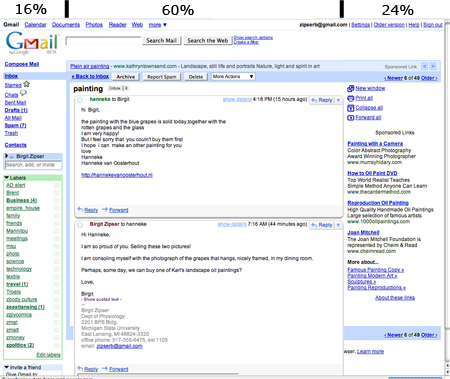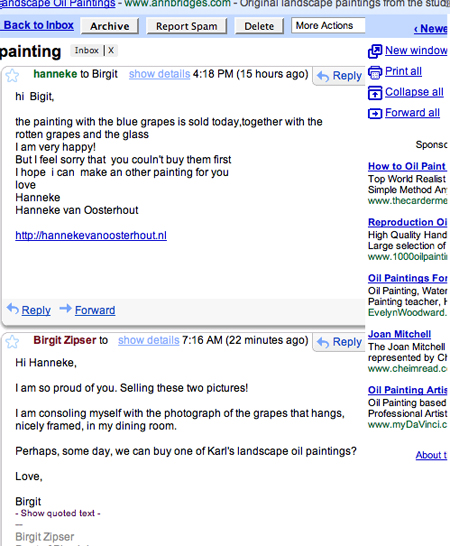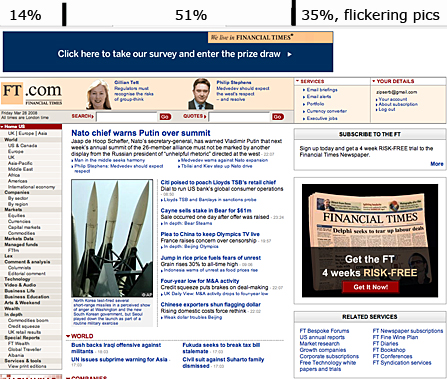‘The right aspect of a web page has a stronger impact on our mind than the left aspect’ is a notion adopted by the advertising world, as I recently learned from one of Steve’s comments.This made me look at the real estate on the web.
For safety, I recently switched to gmail because I lost all my archived email from my apple mail box after innocently agreeing to update the mail box.
Let us look at one of my gmail threads:

Of the total width, the leftmost 16% are dedicated to my archiving, next come my gmail message occupying 60% of the real estate. The right aspect, 24%, contains ads that reflect the content of my message. Emailing with Hanneke van Oosterhout about her grape picture, the ads on the left talk about oil paintings:

As another example of real estate on the web, let us look at one of my favorite news’papers’ on the web,the Financial Times, ft.com:
Here, 51% contains the news that I want to read, not centered, but offset to the left.


My reaction: I enjoy defeating the ads and glory in my complete ignorance of whatever has been advertised in the online NYT, which I read daily. If there’s a subliminal effect I’ve never observed its influence, but then almost nothing I buy would be advertised in the Times.
Despite the prevalence of bad web design and bad advertising, some designers are very knowledgeable about visual perception, and use techniques like eye-tracking studies to optimize their layouts and ads. A key method is to rely on preattentive processing, using visual features like color and motion/change (e.g. blinking) to grab our eye before we consciously direct our attention. A useful discussion with examples is here.
Personally I find any clutter distracting, and my attention to left or right varies from site to site.
In gmail, I pay attention to the left side and the middle, and hardly even notice the ads on the right. On A&P, I pay a lot of attention to the right-hand column, because that’s where the conversation threads are. Anything flashing on my screen motivates me to go elsewhere. I stopped using Yahoo mail because of all the annoying flashing banner ads.
PS – speaking of web real estate, would you all mind testing something out for me.
Here’s a web site I’ve set up to introduce a design business I’m starting. I’ve been able to view it just fine on my home and work computers, but a friend in the UK said his pop-up blocker prevented him from viewing the images. Would you click on the crows, and let me know if you’re able to see the images? Thanks!
http://www.dadabank.com/
Great website, minimalism and ravens.
Works just fine from on my MacBookPro using either Firefox or Safari.
David,
Learning xHTML, CSS now, I was told to use ‘div’ rather than ‘table’ to organize a page. Perhaps that is the issue?
Birgit, I’m pretty happy w/ the page layout, though CSS I’m sure is much better (it’s on my list of things to learn). My only concern for now is that I’ve coded the 5 images to open in separate little pop-up windows when you click on the crows. Works fine on all my computers, but a friend in England wasn’t able to view the pop-ups. Did they open okay on your Mac?
David, sorry, I did not explain sufficiently.
Yes, clicking the ravens, both on safari and firefox, gives different little pop-up windows.
Today, I feel like the raven sitting on the street lamp.
David,
I use Thunderbird, with blocked pop-ups unless I allow them. The bird images come up filling the same window when I click on them with the site being “forbidden” by Scripts (I have to go back to see the home page.) They pop up in a separate window when I “allow” the site — the home page lies open underneath.
I wasn’t prepared to click — I was thinking rollover, so it took me a minute or two to figure out what I was supposed to do. But more on that for Birgit.
Oh, and I’m using a PC.
Birgit,
I am always slow to learn computer analogic language, so your term “real estate” which I had heard before but not so fully explained, made me smile. It’s like the notion of “populating” a page, which, as I understand it, means putting in content….
Anyway, when I first encounter a page with an unfamiliar layout, I’m always slightly annoyed. I don’t look at ads (like David, I’m great for denial of their existence) and I do have in my head the places I want to look for the information I’m after. When someone violates this, I’m irritated.
I find this “denial” fairly universal, and interesting in the art I’m currently doing. I painted a bunch of traffic islands that are used to calm traffic in my neighborhood. About half of the drivers who live in this area and look at my paintings (a small sampling to be sure) don’t even remember that there are such elements in the intersections. I think they use but block them out as irrelevant to anything but getting beyond. Likewise vehicles and pavement — I’ve had complaints that the pavement takes up too much space in my paintings. But the truth is, in the city, the pavement takes up too much space in my life. Most people don’t even notice it, in part because they are in the vehicles while I’m dodging them, fleeing across expanses of pavement.
All this is to say that I like it that I know what not to look at — ads can have the right side and I’ll check out the left — except in A&P, of course. But the knowledge that people aren’t seeing what’s in front of them can be used by the artist to a very different effect.
David,
I use Firefox on Windows with popups blocked. The dadabank page worked for me as you said it should.
Thanks to all. I might try to figure out how to get my crows to change a bit on rollover so people recognize them as links. That’s very useful info, as well as all of your confirmations that the pop-ups basically worked.
June,
But the truth is, in the city, the pavement takes up too much space in my life. Why too much? I love cities that encourage walking like NYC does.
But the knowledge that people aren’t seeing what’s in front of them can be used by the artist to a very different effect. Can you explain?
Steve,
Thanks for the link – my homework for the weekend.
David,
This might be an Explorer issue (or I’m flaunting my complete ignorance of which programs do what) but I can’t open the crows and I get a “pop-up blocked” message as well.
I have a fairly recent Dell Dimension PC
also, if I’m using a site that has flashing things on the side, and I don’t want to leave or can’t avoid being there, I drape a scarf over that portion of the screen. Low tech, and extremely effective.
David:
Not only did I see them but I liked them as well.
June:
This is your country.
Birgit,
The pavement of which I speak isn’t the sidewalks, which are composed, (generally speaking) in my city, of concrete. It’s what we used to call “tarvia”, that I object to. It’s what paves the way for vehicles that wall people off and make them not see traffic islands except as things to get their SUV’s around.
Nancy Hale’s mother, a portrait painter, said that some people think their eyes are to be used solely to prevent them from running into doors. These people disregard the pavement and the traffic islands except as obstacles to avoid.
So, what the artist can do is what we do so well — point out to folks what’s in front of their noses. Like Fra LIppo Lippi in Browning’s poem, which I probably have already quoted to you but which is still a favorite:
“we’re made so that we love
First when we see them painted, things we have passed
Perhaps a hundred times nor cared to see;
And so they are better, painted–better to us,
Which is the same thing. Art was given for that;
God uses us to help each other so,
Lending our minds out. Have you noticed, now,
Your cullion’s hanging face? A bit of chalk,
And trust me but you should, though! How much more,
… This world’s no blot for us,
Nor blank; it means intensely, and means good.”
I’m not sure about the last clause, but I surely do believe that we are made “to lend our minds out.”
Steve,
In Change Blindness, Fig.11, ‘Market, Money and Corner’ have eluded me so far in the link that you provided. I am not going to cheat and freeze the images. – A game not recommended for David.
Thanks to all for helping me test out my site, and for your feedback and suggestions. Seems I need to provide an alternative link for people whose browsers are blocking pop-ups. The goal is to have it viewable by everyone.
Birgit,
You have to move your focus of attention around to different parts of the picture until you notice the difference as a sort of blinking between the two images. The point of change blindness is that you don’t notice these changes without that conscious attention.
Is it change blindness when I don’t notice when someone shaved his moustache?
June,
Thanks for the Browning poem. Lending our minds out is a wonderful view on the world, replacing naked competitiveness.
I still don’t know what ‘tarvia’ means, after reading your comment and googling the word. My innocence may stem from the fact that I live in a village, in the center of a small town and NYC, all pedestrian friendly.
Birgit,
I think I may have the spelling of “tarvia” all wrong which is why you can’t find it. It was common in my youth, but then, at that point in my life I was told to redd up the room (which WP also puts a red line under) and few people know what that means.
(PS. Redding up the room is not painting, but what you do when you see the preacher coming up the walk)
(PS #2: But here, I found a quote for you:
“EDITOR’S NOTE: Following is Chapter 2 of “Adrift in America: Diary of a Minimalist Mariner,” a work found in the nonfiction section:
Sanford, Maine. May 16, 1988.
The late morning sun beats down on King’s Shopping Plaza, warming the truck after a cold night. I open the side windows and smell it. Nearby, men are rebuilding the plaza entrance and several miles of Route 109. I walk along Route 109 and smell it. The smell is everywhere.
Bituminous concrete.
If I were at a party for a young graduate who I thought needed advice about the future, I would lean forward with a crooked grin and whisper just those two words: “Bituminous concrete.”
All right, maybe it isn’t for everybody. Maybe the future belongs to the other petroleum byproduct the other old guy whispered in just one word. But as the years go by, I find fewer redeeming qualities in plastics.
Bituminous concrete – the stuff highways and parking lots are made of, otherwise known as asphalt, blacktop, hot top, macadam, pavement, tar, tarvia or tarmac – covers tens of thousands of square miles of the United States. It is ugly, as only a sludge from decomposed dinosaurs and rotted monster ferns can be. And it is spreading.
But running along it and stretching away from it is still a lot of country.
And most of it is still free.”
– Sid Leavitt
from Readers and writers blog, http://readersandwritersblog.com/2007/04/
I guess Birgit’s acquaintance didn’t have a highly remarkable moustache. Anyway, the question of change blindness was addressed today in an article in the NY Times.